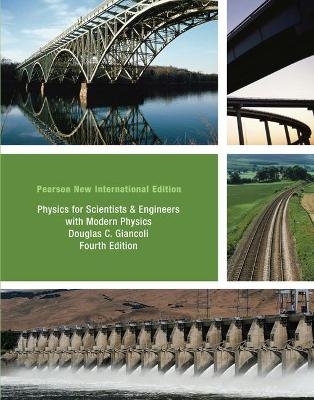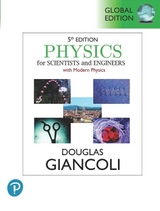
Physics for Scientists & Engineers with Modern Physics Pearson New International Edition, plus MasteringPhysics without eText
Pearson Education Limited
978-1-4479-6528-2 (ISBN)
CONTENTS OF VOLUME 1
APPLICATIONS LIST xii
PREFACE xiv
AVAILABLE SUPPLEMENTS AND MEDIA xxii
NOTES TO STUDENTS (AND INSTRUCTORS) ON THE FORMAT xxiv
COLOR USE: VECTORS, FIELDS, AND SYMBOLS xxv
CHAPTER1: INTRODUCTION, MEASUREMENT, ESTIMATING
1—1 The Nature of Science
1—2 Models, Theories, and Laws
1—3 Measurement and Uncertainty; Significant Figures
1—4 Units, Standards, and the SI System
1—5 Converting Units
1—6 Order of Magnitude: Rapid Estimating
*1—7 Dimensions and Dimensional Analysis
SUMMARY
QUESTIONS
PROBLEMS
GENERAL PROBLEMS
CHAPTER 2: DESCRIBING MOTION: KINEMATICS IN ONE DIMENSION
2—1 Reference Frames and Displacement
2—2 Average Velocity
2—3 Instantaneous Velocity
2—4 Acceleration
2—5 Motion at Constant Acceleration
2—6 Solving Problems
2—7 Freely Falling Objects
*2—8 Variable Acceleration; Integral Calculus
*2—9 Graphical Analysis and Numerical Integration
SUMMARY
QUESTIONS
PROBLEMS
GENERAL PROBLEMS
CHAPTER 3: KINEMATICS IN TWO OR THREE DIMENSIONS; VECTORS
3—1 Vectors and Scalars
3—2 Addition of Vectors–Graphical Methods
3—3 Subtraction of Vectors, and Multiplication of a Vector by a Scalar
3—4 Adding Vectors by Components
3—5 Unit Vectors
3—6 Vector Kinematics
3—7 Projectile Motion
3—8 Solving Problems Involving Projectile Motion
3—9 Relative Velocity
SUMMARY
QUESTIONS
PROBLEMS
GENERAL PROBLEMS
CHAPTER 4: DYNAMICS: NEWTON’S LAWS OF MOTION
4—1 Force
4—2 Newton’s First Law of Motion
4—3 Mass
4—4 Newton’s Second Law of Motion
4—5 Newton’s Third Law of Motion
4—6 Weight–the Force of Gravity; and the Normal Force
4—7 Solving Problems with Newton’s Laws: Free-Body Diagrams
4—8 Problem Solving–A General Approach
SUMMARY
QUESTIONS
PROBLEMS
GENERAL PROBLEMS
CHAPTER 5: USING NEWTON’S LAWS: FRICTION, CIRCULAR MOTION, DRAG FORCES
5—1 Applications of Newton’s Laws Involving Friction
5—2 Uniform Circular Motion–Kinematics
5—3 Dynamics of Uniform Circular Motion
5—4 Highway Curves: Banked and Unbanked
*5—5 Nonuniform Circular Motion
*5—6 Velocity-Dependent Forces: Drag and Terminal Velocity
SUMMARY
QUESTIONS
PROBLEMS
GENERAL PROBLEMS
CHAPTER 6: GRAVITATION AND NEWTON’S6 SYNTHESIS
6—1 Newton’s Law of Universal Gravitation
6—2 Vector Form of Newton’s Law of Universal Gravitation
6—3 Gravity Near the Earth’s Surface; Geophysical Applications
6—4 Satellites and “Weightlessness”
6—5 Kepler’s Laws and Newton’s Synthesis
*6—6 Gravitational Field
6—7 Types of Forces in Nature
*6—8 Principle of Equivalence; Curvature of Space; Black Holes
SUMMARY
QUESTIONS
PROBLEMS
GENERAL PROBLEMS
CHAPTER 7: WORK AND ENERGY
7—1 Work Done by a Constant Force
7—2 Scalar Product of Two Vectors
7—3 Work Done by a Varying Force
7—4 Kinetic Energy and the Work-Energy Principle
SUMMARY
QUESTIONS
PROBLEMS
GENERAL PROBLEMS
CHAPTER 8: CONSERVATION OF ENERGY
8—1 Conservative and Nonconservative Forces
8—2 Potential E
| Verlagsort | Harlow |
|---|---|
| Sprache | englisch |
| Maße | 241 x 297 mm |
| Gewicht | 2800 g |
| Themenwelt | Naturwissenschaften ► Physik / Astronomie |
| ISBN-10 | 1-4479-6528-0 / 1447965280 |
| ISBN-13 | 978-1-4479-6528-2 / 9781447965282 |
| Zustand | Neuware |
| Informationen gemäß Produktsicherheitsverordnung (GPSR) | |
| Haben Sie eine Frage zum Produkt? |
aus dem Bereich



